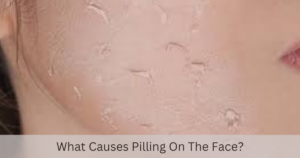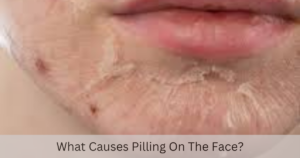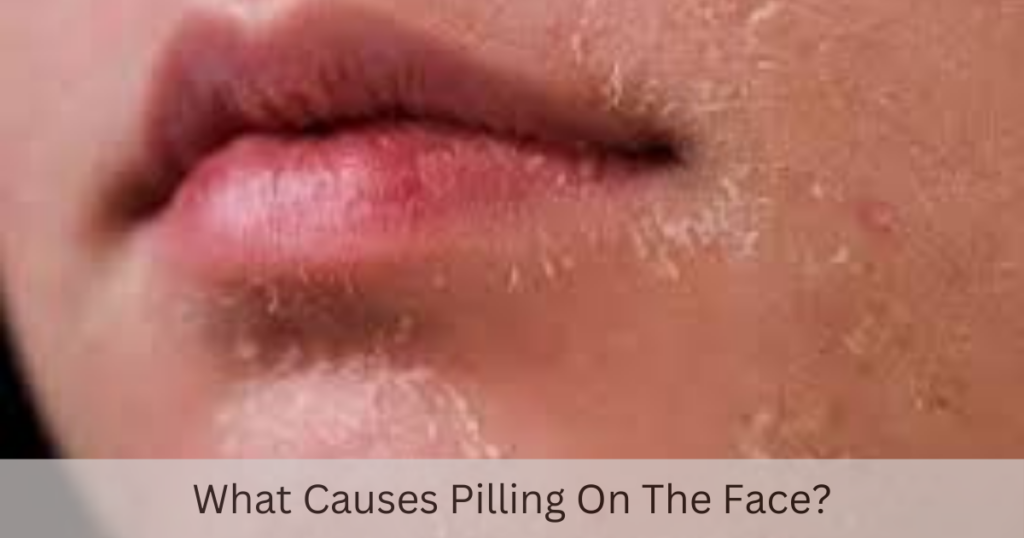What causes pilling on the face? This question often plagues individuals who experience this frustrating skincare issue. Face pilling occurs when small balls of fluff or debris accumulate on the skin’s surface, leading to an uneven texture and appearance. While it’s not harmful, it can be unsightly and bothersome. In this guide, we’ll learn about the ten common causes of face pilling, how to identify them, and effective remedies to restore smooth, radiant skin.

What Causes Pilling On The Face? Is It A Medical Issue?
Face pilling itself is not typically considered a medical issue. Instead, it’s a cosmetic concern that arises due to various factors such as skincare product usage, environmental influences, and skin conditions. While face pilling may not pose a direct threat to health, it can be bothersome and impact one’s confidence in their appearance.
However, in some cases, the underlying causes of face pilling may be related to medical conditions or skin disorders. For instance, certain skin conditions like:
1. Over-Exfoliation
Over-exfoliation refers to the excessive removal of dead skin cells, which can disrupt the skin’s natural barrier and lead to pilling.
- Spotting: Look for signs such as redness, irritation, and increased sensitivity, which may indicate that you’re exfoliating too frequently or using products with harsh exfoliants.
- Remedy: Reduce exfoliation frequency and opt for gentle exfoliants containing ingredients like lactic acid or enzymes. Give your skin time to recover before reintroducing exfoliation.
- Pros: Improved skin texture without over-stripping the skin.
- Cons: Over-exfoliation may cause further irritation and damage if not managed properly.
2. Incompatible Skincare Products
Using skincare products with incompatible ingredients can cause pilling. Certain combinations of ingredients, such as silicones and oils, may not work well together, leading to product buildup and pilling.
- Spotting: Look for product buildup and signs of pilling after applying multiple products. You may notice that certain products don’t seem to absorb well into the skin.
- Remedy: Stick to products with similar bases or consult a dermatologist for personalized recommendations. Pay attention to ingredient lists and avoid using products that contain ingredients known to cause pilling when combined.
- Pros: Clearer skin with reduced product buildup.
- Cons: Limited product options, potential need for trial and error.
3. Incorrect Application Order
Applying skincare products in the wrong order can hinder absorption and lead to pilling. Layering products incorrectly can create a barrier that prevents them from being absorbed effectively.
- Spotting: Notice if products fail to absorb or if pilling occurs shortly after application. You may find that certain products don’t seem to work well together or sit on top of the skin.
- Remedy: Apply products from thinnest to thickest consistency. Start with lightweight serums and essences before moving on to heavier creams and oils. Allow each product to absorb fully before applying the next.
- Pros: Enhanced product efficacy and absorption.
- Cons: Requires extra time and attention to detail.
4. Dehydrated Skin
Dehydrated skin lacks moisture, causing dead skin cells to accumulate and pill. When the skin is dehydrated, it may produce more oil to compensate, leading to congestion and pilling.
- Spotting: Look for signs of tightness, flakiness, and dullness. Dehydrated skin may also appear more oily in some areas while feeling dry and tight in others.
- Remedy: Drink plenty of water to hydrate the skin from the inside out. Incorporate hydrating ingredients like hyaluronic acid into your skincare routine to attract and retain moisture. Use a lightweight, non-comedogenic moisturizer to keep the skin hydrated without clogging pores.
- Pros: Improved skin hydration and elasticity.
- Cons: Requires consistent hydration maintenance.
5. Low-Quality Makeup Products
Using low-quality makeup products can exacerbate face pilling due to their formulation and ingredients. These products may contain cheap fillers or irritants that can cause pilling when applied to the skin.
- Spotting: Notice if pilling occurs after makeup application, especially with certain types of products such as foundations, concealers, or powders.
- Remedy: Invest in higher-quality makeup products from reputable brands known for their formulations. Look for makeup products that are non-comedogenic, fragrance-free, and formulated for your skin type. Avoid products that contain ingredients known to cause irritation or pilling.
- Pros: Reduced risk of skin irritation and breakouts.
- Cons: Higher upfront cost for quality products.
6. Environmental Factors
Environmental factors such as pollution, harsh weather conditions, and indoor heating can strip the skin of its natural oils, leading to pilling. These external stressors can compromise the skin’s barrier function and disrupt its balance.
- Spotting: Notice changes in skin texture and appearance based on environmental exposure. You may find that your skin feels drier, rougher, or more sensitive in certain environments.
- Remedy: Protect your skin from environmental damage by using a daily SPF sunscreen to shield against UV radiation. Consider using a humidifier to add moisture to the air in dry indoor environments. Incorporate antioxidant-rich skincare products to neutralize free radicals and protect against environmental damage.
- Pros: Enhanced skin protection against environmental damage.
- Cons: Requires consistent maintenance and product application.
7. Fabric Friction
Frequent contact between your face and fabrics like towels, pillowcases, or clothing can contribute to face pilling. Rough or abrasive fabrics can create friction against the skin, leading to irritation and pilling.
- Spotting: Notice if pilling occurs in areas of frequent fabric contact, such as the cheeks, forehead, or chin. You may find that your skin feels rough or irritated after using certain fabrics.
- Remedy: Opt for soft, breathable fabrics like cotton or silk that are gentle on the skin. Avoid rubbing or tugging at your skin with towels or clothing. Launder pillowcases and towels regularly to remove buildup and bacteria that can contribute to pilling.
- Pros: Reduced risk of irritation and inflammation.
- Cons: Potential need for lifestyle adjustments.

8. Allergic Reactions
Allergic reactions to skincare or makeup products can manifest as pilling, along with other symptoms such as itching, redness, or swelling. Certain ingredients in skincare or makeup products can trigger allergic reactions in sensitive individuals.
- Spotting: Notice if pilling occurs alongside other symptoms of irritation or allergic reactions. You may find that your skin becomes red, itchy, or inflamed after using certain products.
- Remedy: Patch test new skincare or makeup products before applying them to your face. Apply a small amount of product to a discreet area of skin, such as the inner forearm, and wait 24-48 hours to see if any reaction occurs. If you experience pilling or other signs of irritation, discontinue the use of the product and consult with a dermatologist for further evaluation.
- Pros: Relief from discomfort and irritation.
- Cons: Time-consuming process of elimination and trial.
9. Dead Skin Buildup
Accumulation of dead skin cells can create a barrier, leading to pilling.
- Spotting: Notice if pilling occurs in conjunction with dullness and rough skin texture.
- Remedy: Incorporate gentle exfoliation containing alpha or beta hydroxy acids into your routine. These chemical exfoliants work to dissolve dead skin cells, promoting cell turnover and preventing buildup.
- How to Use: Apply the exfoliant to clean, dry skin and gently massage in circular motions. Rinse thoroughly with lukewarm water and pat dry.
- Pros: Improved product absorption and skin renewal.
- Cons: Potential for irritation if overused.
10. Stress and Hormonal Imbalance
Stress and hormonal fluctuations can affect the skin’s balance, leading to pilling.
- Spotting: Notice changes in skin texture and appearance during periods of stress or hormonal changes.
- Remedy: Practice stress-relief techniques such as meditation, exercise, and adequate sleep to support overall skin health. Additionally, consider seeking medical advice if hormonal imbalances persist.
- Pros: Improved overall well-being and skin health.
- Cons: Requires lifestyle adjustments and potential medical intervention.
Conclusion
Understanding what causes pilling on the face empowers individuals to address this skincare issue effectively. By identifying the underlying causes and implementing targeted remedies, you can restore smooth, radiant skin and enhance your overall complexion.

